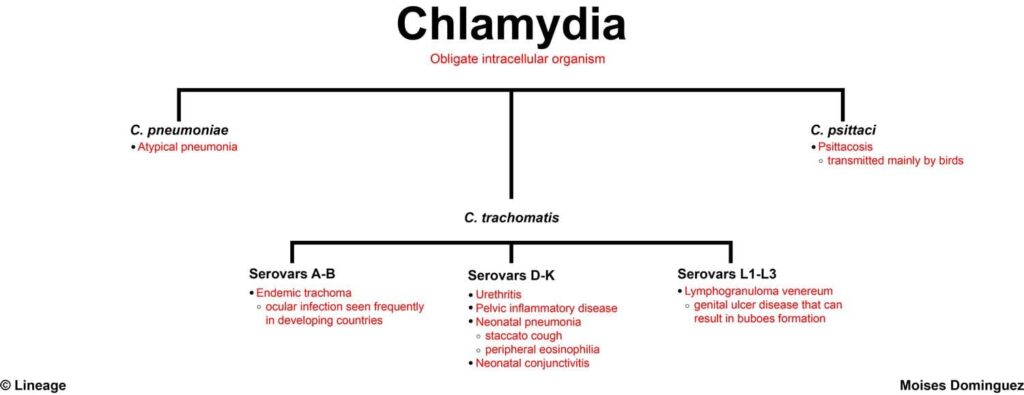Snapshot
- A 5-year-old girl presents to the community clinic with a complaint of an intensely irritating foreign-body sensation in her left eye. On physical exam, she exhibits erratic twitching of her eyelid, inflammatory thickening of the upper tarsal conjunctiva, and evidence of conjunctival scarring. The girl and her family recently arrived in the United States from a refugee camp in Ethiopia, where they lived in crowded sleeping arrangements and had inadequate water access for personal hygiene.
Overview

Introduction
- Classification
- Chlamydia trachomatis
- obligate intracellular bacteria
- Chlamydia trachomatis
- Pathogenesis
- transmission
- sexual intercourse
- passage through birth canal
- trachoma transmitted by hand-to-eye contact and flies
- location of infection
- genital tract
- eyes
- molecular biology
- obligate intracellular organism
- cannot make their own ATP
- requires live cells for growth in laboratory
- 2 forms
- reticulate body
- intracellular, metabolically active, replicating form
- “Reticulate Replicates”
- collections of reticulate bodies can be seen in the cytoplasm under light microscopy and are called “inclusion bodies”
- elementary body
- infectious, inactive, extracellular form
- small, dense
- “Elementary is Enfectious and Enters cell via Endocytosis”
- reticulate body
- infection of mucosal surfaces leads to granulomatous response and damage
- cell wall lacks peptidoglycan
- beta-lactam antibiotics are thus ineffective
- obligate intracellular organism
- transmission
- Diseases
- trachoma
- most common cause of preventable blindness
- serotypes A, B, C
- lymphogranuloma venereum
- serotypes L1-3 (“L for lymphogranuloma”)
- trachoma
- Associated conditions
- co-infection with Neisseria gonorrhoeae
- pelvic inflammatory disease (PID)
Presentation
- Trachoma
- itching and irritation of the eyes and eyelids
- discharge from the eyes containing mucus or pus
- eyelid inflammation
- blepharospasm
- conjunctival scarring
- trichiasis (inward-growing eyelashes)
- Chlamydia
- in females
- dysuria
- yellow mucopurulent discharge from the urethra
- vaginal discharge
- abnormal vaginal bleeding
- dyspareunia
- fever (in pelvic inflammatory disesease)
- asymptomatic in 80% of patients
- in males
- dysuria
- yellow mucopurulent discharge from the urethra
- unilateral pain and swelling of the scrotum
- fever
- asymptomatic in 50% of patients
- in newborns
- symptoms of conjunctivitis beginning at 1-2 weeks
- eye discharge
- eyelid swelling
- symptoms of pneumonia beginning at 1-3 months
- cough
- fever
- symptoms of conjunctivitis beginning at 1-2 weeks
- in females
- Lymphogranuloma venereum
- painful, localized inguinal adenopathy (buboes)
- genital ulceration
Studies
- Laboratory diagnosis
- nucleic acid amplification test (NAAT)
- cytology for diagnosing infant conjunctivitis and trachoma
- visualization of intracytoplasmic inclusions
- Histology
- cytoplasmic inclusions (reticulate bodies)
- seen on Giemsa or fluorescent antibody-stained smear
- cytoplasmic inclusions (reticulate bodies)
- Additional studies
- pregnancy test for females with suspected chlamydial infection
- doxycycline contraindicated in pregnancy
- pregnancy test for females with suspected chlamydial infection
- strongly consider testing sexual partners for Chlamydia
Differential
- Bacterial vaginosis
- distinguishing factor
- gray vaginal discharge with a fishy smell
- distinguishing factor
- Trichomonas vaginitis
- distinguishing factor
- frothy, yellow-green discharge
- motile trichomonads on wet mount
- distinguishing factor
- Urinary tract infection
- distinguishing factor
- lack of cytoplasmic inclusions seen on Giemsa or fluorescent antibody-stained smear
Treatment
- Medical
- doxycycline
- add ceftriaxone for possible concomitant N. gonorrhoeae infection
- contraindicated in pregnant patients due to risk of teeth discoloration in the fetus
- doxycycline
- topical and oral erythromycin for neonatal chlamydial conjunctivitis
Complications
- Pelvic inflammatory disease (PID)
- may include
- salpingitis
- endometritis
- hydrosalpinx
- tubo-ovarian abscess
- may include
- risk factor for ectopic pregnancy, infertility, chronic pelvic pain, and adhesions



